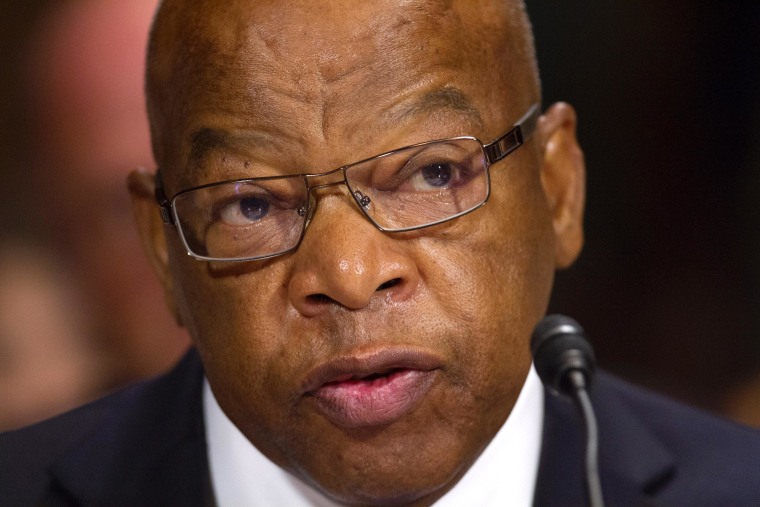1.) Lewis, at the age of 23 and a leader in the civil rights movement, took the podium at the March on Washington in 1963 as the youngest speaker. He's also the only living speaker from the '63 March. From The Grio:
Lewis served as the chairman of the Student Nonviolent Coordinating Committee from 1963 to 1966. He was also a freedom rider in the early to mid-‘60s who endured brutal beatings and multiple arrests to end racial segregation on interstate buses in the South. In 1965, he led a march for voting rights from Selma, Ala., to Montgomery in what later became known as Bloody Sunday, when police attacked the marchers and Lewis suffered a skull fracture in the melee.
2.) His boyhood admiration of comic books inspired his newly-released graphic-novel memoir, “March,” which, fittingly, is depicted throughout with an artist’s renderings of the congressman’s life. From the Washington Post:
First, reading them began as a boyhood passion:
“I read comic books and the comic strips, and my brothers would read the newspaper every single day,” Lewis tells Comic Riffs of those days in the ‘40s and ‘50s. “We were too poor to have a subscription, but my grandfather had one.”
On Sundays, he notes, he especially relished those Sunday color comics.
Some years later, Lewis came upon the ‘50s comic book “Martin Luther King and the Montgomery Story,” which centered on the 1955 bus boycott. Its lessons about nonviolent protest — spotlighting such historic figures as Gandhi and Rosa Parks — struck a chord.
3.) As a comic book fan, why wouldn't he make the trek to Comic-Con? He got to meet some of his "incredible" fans when discussing his new book. From the New York Times:
Last month, the congressman made a splash at Comic-Con in San Diego, where Lou Ferrigno, the original “Incredible Hulk,” was among the fans who lined up to see him. But it was serious business, a way for him to reach young people, Mr. Lewis said, and fulfill his duty to “bear witness.”
4.) Just months after leading a march through Selma, Alabama, that would become known as Bloody Sunday, the young Lewis returned to Washington, D.C. to witness history. From the New York Times:
…after Alabama State Police officers beat him and fractured his skull while he led a march in Selma [in March 1965] , he was back in Washington [in August] to witness President Lyndon B. Johnson sign the Voting Rights Act of 1965.
5.) Now 73, the longtime congressman continues to engage in civil rights issues. From the New York Times:
With the Voting Rights Act in jeopardy now that the Supreme Court has invalidated one of its central provisions, Mr. Lewis, a Democrat, is fighting an uphill battle to reauthorize it. He is using his stature as a civil rights icon to prod colleagues like the Republican leader, Representative Eric Cantor of Virginia, to get on board. He has also met with the mother of Trayvon Martin and compared his shooting to the 1955 murder of 14-year-old Emmett Till.
6.) Just shy of speaking at the 1963 March on Washington, Lewis toned down his rhetoric at the request of Martin Luther King Jr. and other organizers. From The Atlanta Journal-Constitutional:
Fifty years ago, about a half-hour before Lewis was scheduled to speak at the Lincoln Memorial, a backstage powwow formed around the 23-year-old head of the Student Nonviolent Coordinating Committee.
There were a few phrases in his speech that the old guard of the movement --- and the White House --- did not like. In particular, Lewis planned to invoke the name of Gen. William Tecumseh Sherman, whose march to the sea still rankled white Southerners a century later.
"John, this doesn't sound like you," pleaded the Rev. Martin Luther King Jr.
Their demands "incensed" him, he says now. Nevertheless, he said, "I couldn't say no to Dr. King. I couldn't say no to (march organizer) A. Philip Randolph."
Even softened, the speech was a powerful indictment of both political parties' inaction on civil rights.
7.) House Majority Leader Eric Cantor joined Lewis in Selma for this year’s re-enactment of the 1965 march. From the New York Times:
Each year, Mr. Lewis leads an emotional re-enactment in Selma of the “Bloody Sunday” march across the Edmund Pettus Bridge, where the brutal police response horrified the nation. Mr. Cantor participated this year, bringing his college-age son, and said he came away “very moved” — a sentiment that Mr. Lewis will play on during negotiations over a new bill.
“John is what I call a gentle spirit,” said Roy Barnes, a former Georgia governor, recalling a visit by Mr. Lewis in 2001 when he was wrestling with removing the Confederate emblem from the state flag.
“He said, ‘Right before I lost consciousness, I looked up and saw an Alabama state trooper beating me on the Edmund Pettus Bridge, and all I could see was a Confederate flag on his helmet,’ ” Mr. Barnes recalled. “He said, ‘I want you to remember that.’”
